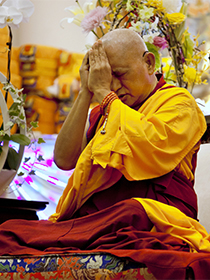- Home
- FPMT Homepage
Foundation for the Preservation of the Mahayana Tradition
The FPMT is an organization devoted to preserving and spreading Mahayana Buddhism worldwide by creating opportunities to listen, reflect, meditate, practice and actualize the unmistaken teachings of the Buddha and based on that experience spreading the Dharma to sentient beings. We provide integrated education through which people’s minds and hearts can be transformed into their highest potential for the benefit of others, inspired by an attitude of universal responsibility and service. We are committed to creating harmonious environments and helping all beings develop their full potential of infinite wisdom and compassion. Our organization is based on the Buddhist tradition of Lama Tsongkhapa of Tibet as taught to us by our founders Lama Thubten Yeshe and Lama Thubten Zopa Rinpoche.
- Willkommen
Die Stiftung zur Erhaltung der Mahayana Tradition (FPMT) ist eine Organisation, die sich weltweit für die Erhaltung und Verbreitung des Mahayana-Buddhismus einsetzt, indem sie Möglichkeiten schafft, den makellosen Lehren des Buddha zuzuhören, über sie zur reflektieren und zu meditieren und auf der Grundlage dieser Erfahrung das Dharma unter den Lebewesen zu verbreiten.
Wir bieten integrierte Schulungswege an, durch denen der Geist und das Herz der Menschen in ihr höchstes Potential verwandelt werden zum Wohl der anderen – inspiriert durch eine Haltung der universellen Verantwortung und dem Wunsch zu dienen. Wir haben uns verpflichtet, harmonische Umgebungen zu schaffen und allen Wesen zu helfen, ihr volles Potenzial unendlicher Weisheit und grenzenlosen Mitgefühls zu verwirklichen.
Unsere Organisation basiert auf der buddhistischen Tradition von Lama Tsongkhapa von Tibet, so wie sie uns von unseren Gründern Lama Thubten Yeshe und Lama Thubten Zopa Rinpoche gelehrt wird.
- Bienvenidos
La Fundación para la preservación de la tradición Mahayana (FPMT) es una organización que se dedica a preservar y difundir el budismo Mahayana en todo el mundo, creando oportunidades para escuchar, reflexionar, meditar, practicar y actualizar las enseñanzas inconfundibles de Buda y en base a esa experiencia difundir el Dharma a los seres.
Proporcionamos una educación integrada a través de la cual las mentes y los corazones de las personas se pueden transformar en su mayor potencial para el beneficio de los demás, inspirados por una actitud de responsabilidad y servicio universales. Estamos comprometidos a crear ambientes armoniosos y ayudar a todos los seres a desarrollar todo su potencial de infinita sabiduría y compasión.
Nuestra organización se basa en la tradición budista de Lama Tsongkhapa del Tíbet como nos lo enseñaron nuestros fundadores Lama Thubten Yeshe y Lama Zopa Rinpoche.
A continuación puede ver una lista de los centros y sus páginas web en su lengua preferida.
- Bienvenue
L’organisation de la FPMT a pour vocation la préservation et la diffusion du bouddhisme du mahayana dans le monde entier. Elle offre l’opportunité d’écouter, de réfléchir, de méditer, de pratiquer et de réaliser les enseignements excellents du Bouddha, pour ensuite transmettre le Dharma à tous les êtres. Nous proposons une formation intégrée grâce à laquelle le cœur et l’esprit de chacun peuvent accomplir leur potentiel le plus élevé pour le bien d’autrui, inspirés par le sens du service et une responsabilité universelle. Nous nous engageons à créer un environnement harmonieux et à aider tous les êtres à épanouir leur potentiel illimité de compassion et de sagesse. Notre organisation s’appuie sur la tradition guéloukpa de Lama Tsongkhapa du Tibet, telle qu’elle a été enseignée par nos fondateurs Lama Thoubtèn Yéshé et Lama Zopa Rinpoché.
Visitez le site de notre Editions Mahayana pour les traductions, conseils et nouvelles du Bureau international en français.
Voici une liste de centres et de leurs sites dans votre langue préférée
- Benvenuto
L’FPMT è un organizzazione il cui scopo è preservare e diffondere il Buddhismo Mahayana nel mondo, creando occasioni di ascolto, riflessione, meditazione e pratica dei perfetti insegnamenti del Buddha, al fine di attualizzare e diffondere il Dharma fra tutti gli esseri senzienti.
Offriamo un’educazione integrata, che può trasformare la mente e i cuori delle persone nel loro massimo potenziale, per il beneficio di tutti gli esseri, ispirati da un’attitudine di responsabilità universale e di servizio.
Il nostro obiettivo è quello di creare contesti armoniosi e aiutare tutti gli esseri a sviluppare in modo completo le proprie potenzialità di infinita saggezza e compassione.
La nostra organizzazione si basa sulla tradizione buddhista di Lama Tsongkhapa del Tibet, così come ci è stata insegnata dai nostri fondatori Lama Thubten Yeshe e Lama Zopa Rinpoche.
Di seguito potete trovare un elenco dei centri e dei loro siti nella lingua da voi prescelta.
- 欢迎 / 歡迎
简体中文
“护持大乘法脉基金会”( 英文简称:FPMT。全名:Foundation for the Preservation of the Mahayana Tradition) 是一个致力于护持和弘扬大乘佛法的国际佛教组织。我们提供听闻,思维,禅修,修行和实证佛陀无误教法的机会,以便让一切众生都能够享受佛法的指引和滋润。
我们全力创造和谐融洽的环境, 为人们提供解行并重的完整佛法教育,以便启发内在的环宇悲心及责任心,并开发内心所蕴藏的巨大潜能 — 无限的智慧与悲心 — 以便利益和服务一切有情。
FPMT的创办人是图腾耶喜喇嘛和喇嘛梭巴仁波切。我们所修习的是由两位上师所教导的,西藏喀巴大师的佛法传承。
繁體中文
護持大乘法脈基金會”( 英文簡稱:FPMT。全名:Found
ation for the Preservation of the Mahayana Tradition ) 是一個致力於護持和弘揚大乘佛法的國際佛教組織。我們提供聽聞, 思維,禪修,修行和實證佛陀無誤教法的機會,以便讓一切眾生都能 夠享受佛法的指引和滋潤。 我們全力創造和諧融洽的環境,
為人們提供解行並重的完整佛法教育,以便啟發內在的環宇悲心及責 任心,並開發內心所蘊藏的巨大潛能 — 無限的智慧與悲心 – – 以便利益和服務一切有情。 FPMT的創辦人是圖騰耶喜喇嘛和喇嘛梭巴仁波切。
我們所修習的是由兩位上師所教導的,西藏喀巴大師的佛法傳承。 察看道场信息:
- FPMT Homepage
- News/Media
-
- Study & Practice
-
-
- About FPMT Education Services
- Latest News
- Programs
- New to Buddhism?
- Buddhist Mind Science: Activating Your Potential
- Heart Advice for Death and Dying
- Discovering Buddhism
- Living in the Path
- Exploring Buddhism
- FPMT Basic Program
- FPMT Masters Program
- FPMT In-Depth Meditation Training
- Maitripa College
- Lotsawa Rinchen Zangpo Translator Program
- Universal Education for Compassion & Wisdom
- Online Learning Center
-
- Prayers & Practice Materials
- Overview of Prayers & Practices
- Full Catalogue of Prayers & Practice Materials
- Explore Popular Topics
- Benefiting Animals
- Chenrezig Resources
- Death & Dying Resources
- Lama Chopa (Guru Puja)
- Lama Zopa Rinpoche: Compendium of Precious Instructions
- Lama Zopa Rinpoche: Life Practice Advice
- Lama Zopa Rinpoche Practice Series
- Lamrim Resources
- Mantras
- Prayer Book Updates
- Purification Practices
- Sutras
- Thought Transformation (Lojong)
- Audio Materials
- Dharma Dates - Tibetan Calendar
- Translation Services
- Publishing Services
- Ways to Offer Support
- Prayers & Practice Materials
-
- Teachings and Advice
- Find Teachings and Advice
- Lama Zopa Rinpoche Advice Page
- Lama Zopa Rinpoche: Compendium of Precious Instructions
- Lama Zopa Rinpoche Video Teachings
- ༧སྐྱབས་རྗེ་བཟོད་པ་རིན་པོ་ཆེ་མཆོག་ནས་སྩལ་བའི་བཀའ་སློབ་བརྙན་འཕྲིན།
- Podcasts
- Lama Yeshe Wisdom Archive
- Buddhism FAQ
- Dharma for Young People
- Resources on Holy Objects
- Teachings and Advice
-
-
*If a menu item has a submenu clicking once will expand the menu clicking twice will open the page.
-
-
- Centers
-
- Teachers
-
- Projects
-
-
-
-
*If a menu item has a submenu clicking once will expand the menu clicking twice will open the page.
-
-
- FPMT
-
-
-
-
-
You can see from your own life experiences how the environment can affect you. When you’re among peaceful, generous, happy people, you’re inclined to feel happy and peaceful yourself. When you’re among angry, aggressive people, you tend to become like them. The human mind is like a mirror. Therefore, it is very important to be conscious of your surroundings and how they affect your mind.
Share
Lama Thubten Yeshe
-
-
-
- Shop
-
-
-
The Foundation Store is FPMT’s online shop and features a vast selection of Buddhist study and practice materials written or recommended by our lineage gurus. These items include homestudy programs, prayers and practices in PDF or eBook format, materials for children, and other resources to support practitioners.
Items displayed in the shop are made available for Dharma practice and educational purposes, and never for the purpose of profiting from their sale. Please read FPMT Foundation Store Policy Regarding Dharma Items for more information.
-
-
25
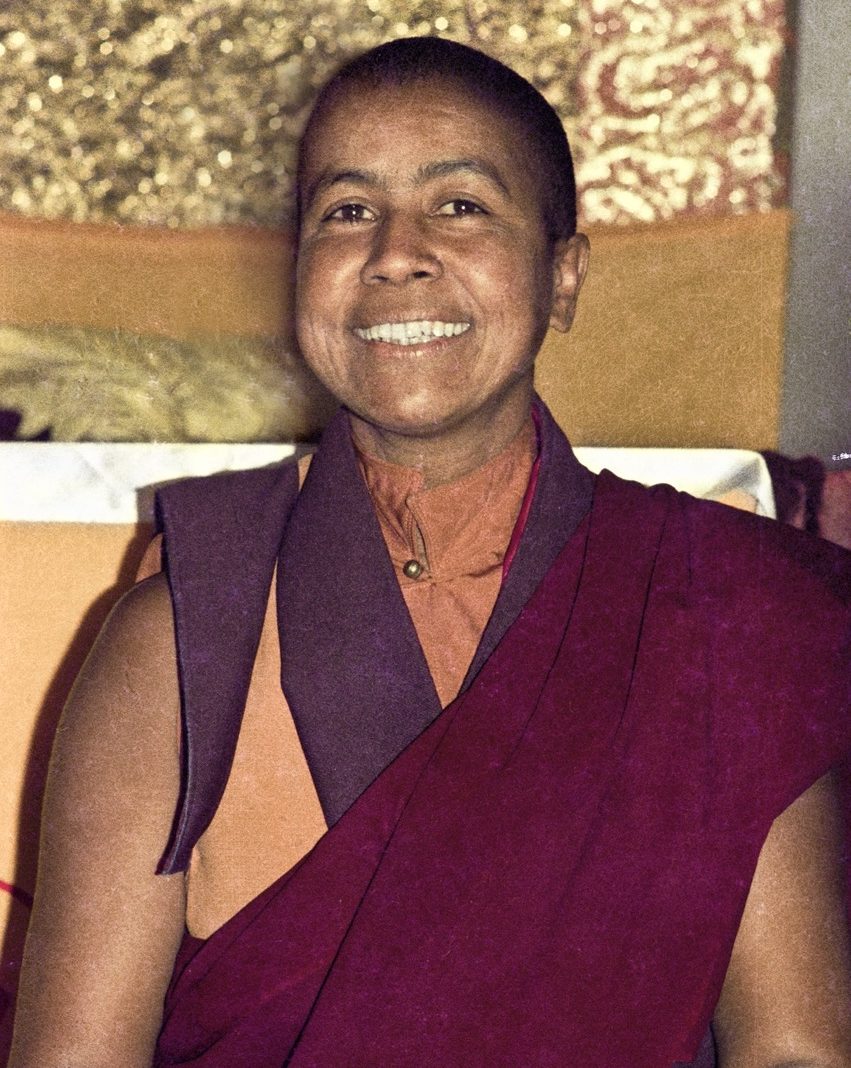
Sister Max giving a talk during the month-long course at Chenrezig Institute, Australia, 1975. Photo courtesy of LYWA collection.
The entire FPMT community shared the loss of one of FPMT’s precious pioneers, when “Mummy” Max Mathews (also known as Sister Max), passed away on February 16, 2024. Mummy Max contributed greatly and financially assisted Lama Yeshe and Lama Zopa Rinpoche in establishing Kopan Monastery and the FPMT organization.
Max lived a fascinating life, full of many adventures. Please enjoy this collection of stories, shared from various perspectives, about and from Mummy Max, and rejoice in a full and generous life in service to others, most notably, Lama Yeshe and Lama Zopa Rinpoche.
Mummy Max explains in Volume One of Big Love: The Life and Teachings of Lama Yeshe: “I felt I had come home and that Lama Yeshe was my guru. He just opened me up completely. I felt balanced and whole, like I was walking on air. I also felt committed. There was no going back.”
“These boys need a mother,” Lama Yeshe told Max [Mathews], when they arrived at Kopan. “You are their Mummy Max.” From Big Love
Chapters
Remembering the Most Amazing Sister Mummy Max | A Very Brief Look at Max’s Many Contributions |
The Car that Saved Mount Everest Centre | Words of Thanks and Reverence for Max Mathews |
The Final Days: A Peaceful Transition
Remembering the Most Amazing Sister Mummy Max
By Peter Kedge, friend of Max’s and another early student and pioneer of FPMT
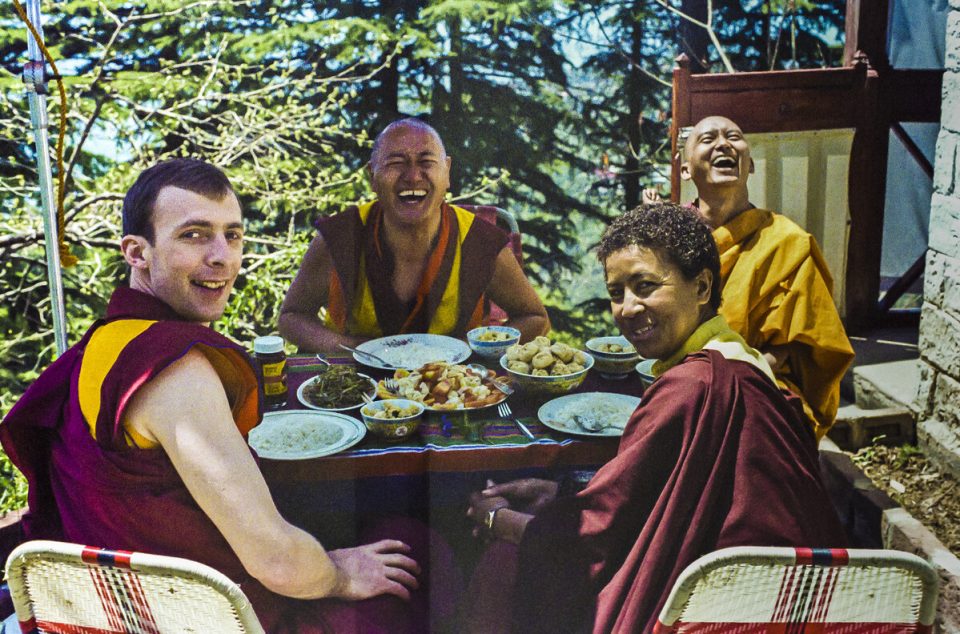
Lama Yeshe, Max Mathews, Peter Kedge, Lama Zopa Rinpoche, First Enlightened Experience, Tushita Meditation Centre, India, 1982. Photo courtesy of LYWA collection.
Born in England, I went to school and University, and in 1966, met up with future FPMT students Harvey Horrocks and Philip Elliott when we worked at the Rolls Royce Aero Engine Division in Derby. We had many adventures together, the highlight of which was probably driving from England to Kathmandu with a plan of eventually reaching Australia.
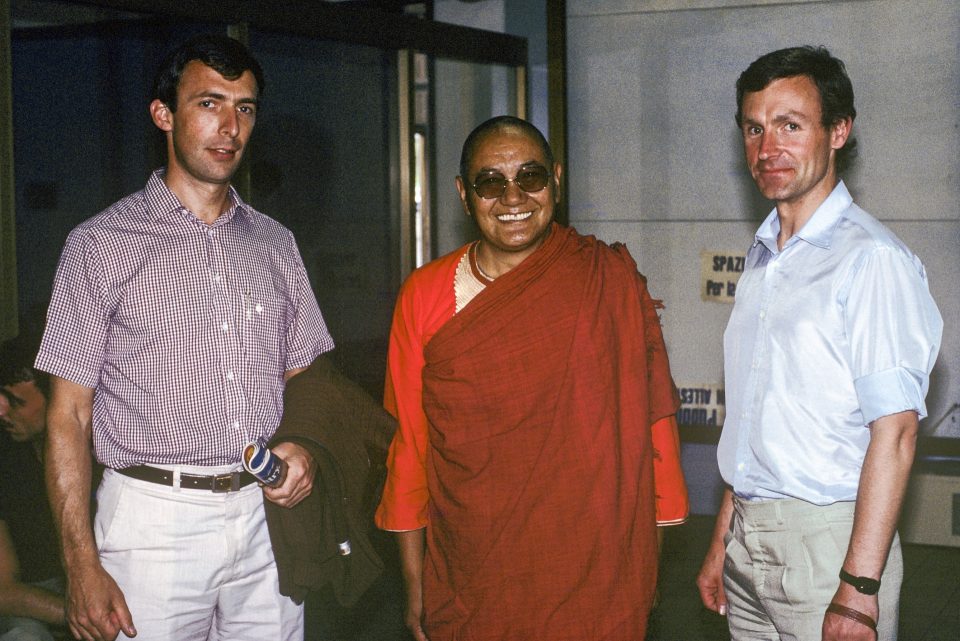
Peter Kedge and Harvey Horrocks with Lama Yeshe at the Pisa airport, Italy, 1983.
Tired of driving, camping on beaches, and exploring the countries we traveled through, we spent six months volunteering with a Christian mission in Pokhara, Western Nepal. We climbed Tent peak in the Annapurna Sanctuary—an experience from which we barely escaped with our lives. We were clearly not mountaineers, and we were clearly not missionary material and so left our hosts to return to Kathmandu.
Harvey and I trekked to Everest Base Camp and another peak, Kala Pattar. On the way we stayed in Namche Bazaar, where I tried meditating for the first time by following instructions from the hippie Bible, Be Here Now by Ram Dass, which one of our female companions was carrying.
On return to Kathmandu days later, I heard there was a Buddhist monastery outside Kathmandu with a Canadian nun, and they were offering a meditation course in English.
Harvey and Philip continued on to Australia. I stayed, and in March 1972, showed up for the second Kopan Course with about 10 others led by Canadian nun Ann McNeil, Canadian monk Jampa Shaneman, and taught by Lama Zopa Rinpoche.
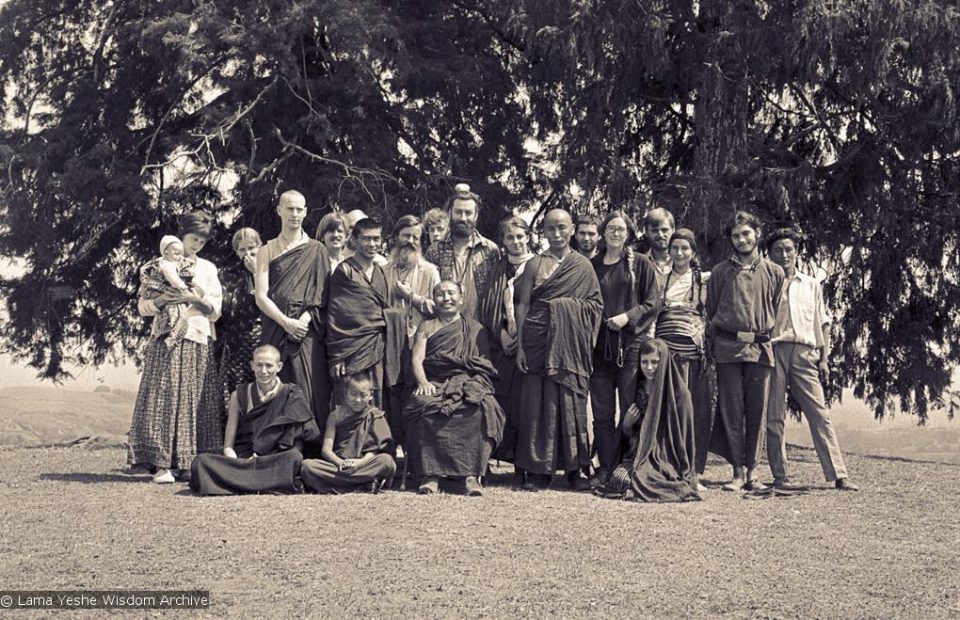
Second Kopan Meditation Course, spring of 1972. Included in the photo from the left are Ann McNeil (Anila Ann), Mark Shaneman (Jhampa Zangpo), Steve Malasky, Gen Wangyal, Age Delbanco (Babaji), Peter Kedge, Geshe Thubten Tashi (seated), Losang Nyima. Photo courtesy of the Lama Yeshe Wisdom Archive.
During the break times, I heard there was also an American nun associated with Kopan who visited from Kathmandu where she was a teacher at the U.S. International Lincoln School.
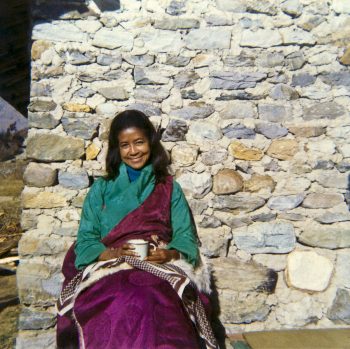
The first trek to Lawudo Retreat Center in Nepal, spring of 1969. Photo courtesy of LYWA collection.
I didn’t see another nun, or at least I didn’t see anyone looking like a nun, until one evening, a black lady in a purple trouser suit drove up and I learned that was Max Mathews the American nun, and the main benefactor of Kopan at that time.
Max heard something about my background, and on introducing herself to me said, “Honey, can you fix cars?” I spent the next three months living in the Rana house Max rented in Tinchuli just outside Boada, and repairing her 1932 Hudson that Max had bought from the King’s palace (see story about Max’s Hudson below).
That was the beginning of 50+ years of close friendship that sadly ended when Max passed earlier this year.
There are two things I remember Max for.
One is the extraordinary karma by which Max’s life brought the foundations of Kopan together.
The other is Max’s unreserved generosity.
Max was born into abject poverty in Redford, Virginia, on October 11, 1933.
After her parents died, social services placed Max with a local family which Max didn’t get on with, so she upped and left for New York to stay with her older sister until social services caught up and placed her with a wealthy family of lawyers in Washington D.C.
Suddenly, Max was circulating in, and learning how to be part of, high society. Later with her Columbia University Master’s degree, government job, diplomatic passport, and postings to Germany, Greece, and Moscow, Max was living life with the elite of the world.
During teaching breaks in Athens, Greece, Max holidayed on the island of Mykonos where she met Ann McNeil (later Anila Ann). Max met Zina Rachevsky (who would become Lama Yeshe and Lama Zopa Rinpoche’s first Western student) in Athens and took Ann to meet Zina. When Max moved on from Athens to Moscow, they each took different paths for the next three years.
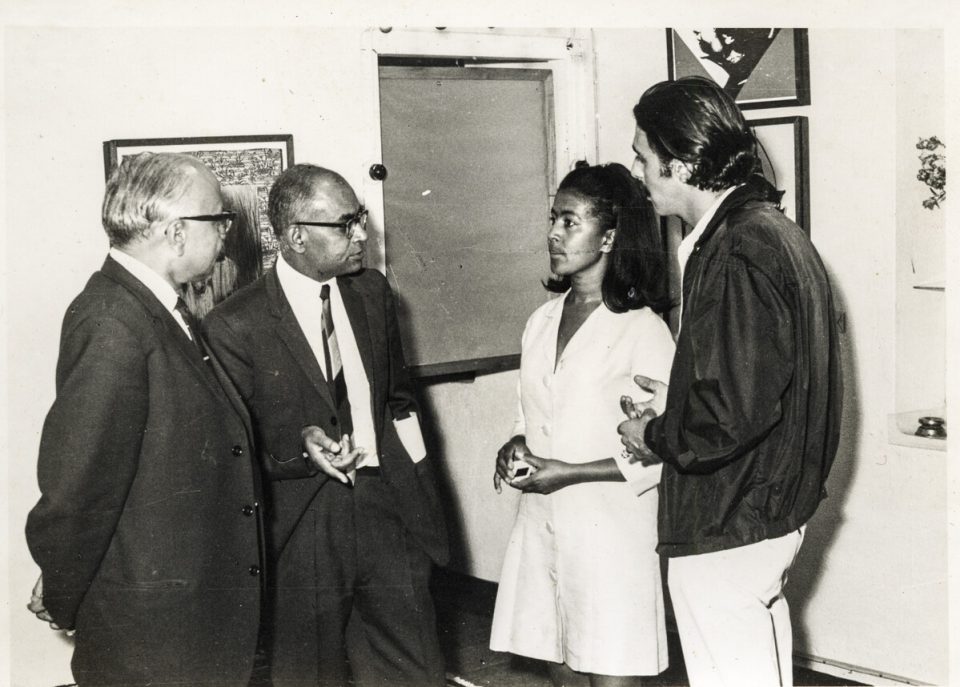
Max Mathews hosting an event at her art gallery in Kathmandu, Nepal, 1969. Photo courtesy of LYWA collection.
Then during Max’s posting to Lincoln School in Kathmandu, Nepal, Zina one day appeared from Darjeeling with Lama Yeshe and Lama Zopa Rinpoche. Zina introduced Max to the lamas and on meeting Lama Yeshe, Max collapsed in tears. From then on her life’s purpose was clear.
Zina asked Max to look after the lamas financially because Zina was out of money and Max agreed. Max contacted Ann in Greece and asked her to come to Kathmandu to help her look after the lamas as well.
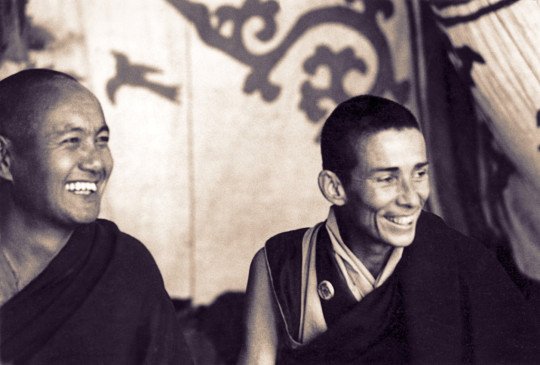
Lama Yeshe with Anila Ann (Ann McNeil), Kopan Monastery, Nepal, 1974. Photo courtesy of the Lama Yeshe Wisdom Archive.
And there they were—Lama Yeshe, Lama Zopa, Zina, Max, and Ann, together in Kathmandu. They were the pioneers establishing the foundation of Kopan and eventually, the entire FPMT organization. Ann, Max, and Zina all took ordination.
For me, the karma that brought that about and all that has followed is nothing short of mind blowing.
The most outstanding quality of Max has always been her unreserved generosity—firstly and foremost toward Lama Yeshe, Lama Zopa, and the Mount Everest Centre (which grew into Kopan Monastery and later, Nunnery as well).
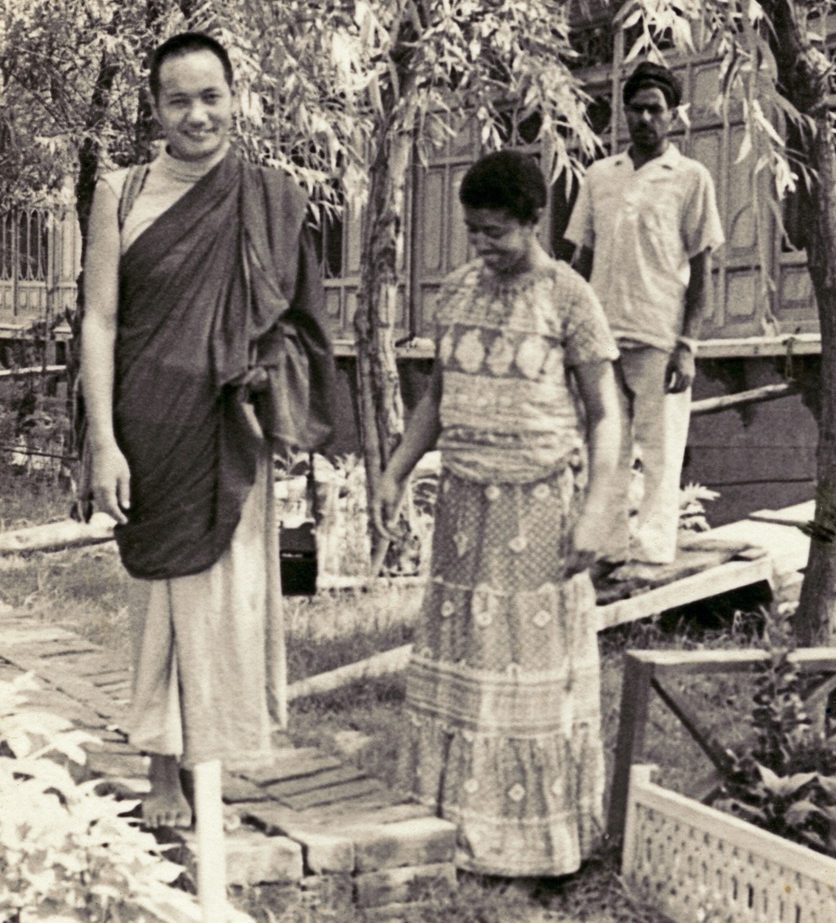
Lama Yeshe on holiday with Max Mathews in Srinagar, Kashmir, 1970. Photo by Domo Geshe Rinpoche who also accompanied them.
Whatever the lamas needed for their well-being and projects, Max did her utmost to fulfill. When Max received her salary check from Lincoln School, she would bring it to Kopan, and give the check to me to take down to Kathmandu and convert it to Nepalese rupees.
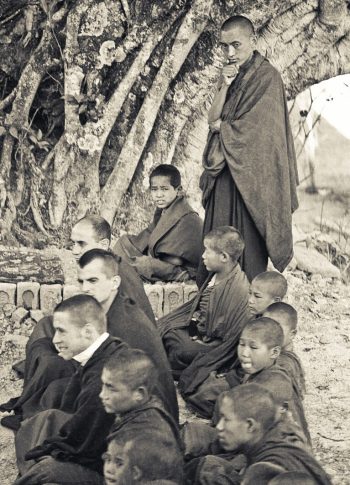
Lama Zopa Rinpoche with Mount Everest Centre boys beside the ancient bodhi tree at Kopan Monastery, Nepal, 1974. Photo by Ursula Bernis.
The rupees would come back up to Kopan and they would be used for whatever Lama Yeshe needed, and now with young Sherpa Mount Everest Centre monks to care for, it meant robes, food, fuel, and accommodations that had to be built as well as a gompa. So Max’s salary also went to buy cement, iron re-bar, sand, bricks, to hire laborers, and pay for trucks to bring all these supplies up to Kopan.
This was Max. Whatever was needed, Max would provide. And not only for the lamas. There was an increasing number of people that Max supported—Tibetans, Nepalese, older monks at Kopan, former monks who had escaped with Lama Yeshe from Tibet, Anila Ann, and other Westerners.
Max became known as, “Mummy Max” as that was the role Max played for so many.
Soon, a teacher’s salary was not enough. Max stopped working at Lincoln School and went headlong into business determined to generate more income.
Max started making garments in Kathmandu and then later in Delhi. Max became so successful she was featured in Time magazine with her fabulous line of sequined dresses, which sold for hundreds of dollars in New York.
Max completely supported Lama. When eventually Lama’s health declined, Max paid doctors’ bills and air tickets. Max flew Lama to Delhi, paid for more specialists and hospitals, flew Lama first class to California, paid for Lama’s treatment at Cedar Sinai Hospital, an air ambulance, and all of Lama’s care. Max offered her credit card and made it completely available to cover the considerable expenses of Lama’s funeral at Vajrapani Institute. This was Max’s utter devotion. Lama and Rinpoche always came first.
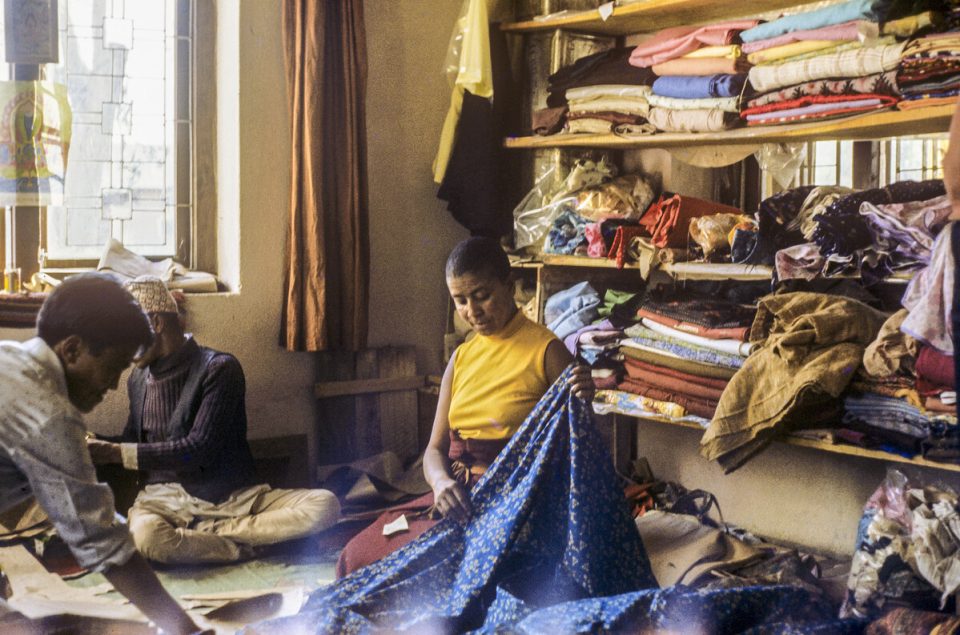
Max Mathews with fabric for her clothing business, New Delhi, 1976. Photo courtesy of LYWA collection.
The last few months of Lama Yeshe’s life took Max ‘s focus away from the business and unfortunately some of her associates took advantage of Max’s absence during those months and the garment business collapsed.
Even after Lama’s passing, Max was determined to generate funds for Rinpoche, Kopan, and the growing sangha.
Max switched from garments to Indian antique furniture which Max exported to the United States. Max took up residence in Colorado and opened a furniture gallery, traveling back and forth to India to buy stock.
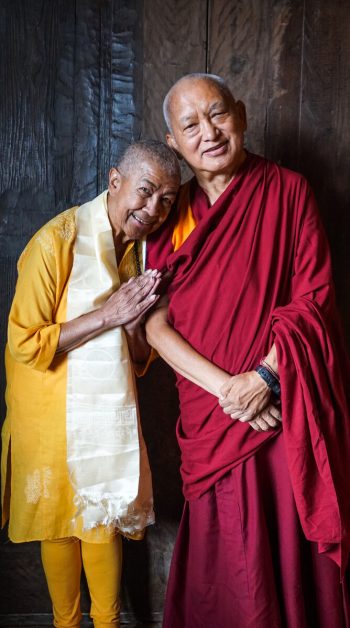
Sister Max and Lama Zopa Rinpoche, United States, August 10, 2017. Photo by Lobsang Sherab.
At almost 80 Max moved into senior housing in Santa Fe and became close with Thubten Norbu Ling, the FPMT center there.
Max never stopped trying to raise money for Rinpoche, the Santa Fe center, and her many other projects. Some of the schemes Max tried were online and unfortunately involved people who took advantage of her trusting nature.
At 88, Max still had a vision of creating, “the most fabulous gallery and restaurant” in the building the center had recently purchased.
Max never sought recognition or thanks. She always downplayed the incredibly significant part she had played in building Kopan, helping Lama and Rinpoche to build FPMT, and as a consequence, helping the spread of Buddha Dharma in the West.
Max’s passing was as close to “textbook” as can be hoped for. Students of the center and visiting geshes kept a prayer vigil. Nursing staff and hospice carers were on hand 24 hours a day and Max passed peacefully at home. The funeral home allowed the body to remain in place packed by dry ice until the consciousness had left.
Of her part in the establishment of Kopan, Max would always say, “I didn’t do anything.” Yet what an incredible life Max packed into her 90 years. What an example of generosity, what an understated contribution Max made to Kopan, and to the life work of Lama Yeshe and Lama Zopa Rinpoche.
Written by Peter Kedge, friend to Max and early FPMT student, former FPMT Inc. board member, and former director and CEO of the Maitreya Project. Please read this 1995 Mandala magazine article about Peter’s own generous contributions to the early activities of FPMT, “Turning Money into Dharma.”
A Very Brief Look at Max’s Many Contributions
This interview with Max Mathews was filmed in July, 2020 in Santa Fe, New Mexico, with images from Big Love: The Life and Teachings of Lama Yeshe. Mummy Max shares her spontaneous and intimate firsthand stories of her timeless relationship with Lama Yeshe and Lama Zopa Rinpoche:
Watch Big Love: An Interview with Max Mathews aka Mummy Max
https://www.youtube.com/watch?v=eQMNDG7-ocE
Adele Hulse writes of Max’s early years in Big Love:
Born in 1933 to a desperately poor black undertaker in Virginia, Max and her siblings had often helped embalm bodies after school. “Embalming was all the go with poor blacks,” she said. Her parents’ marriage broke up when she was around ten years old and she was adopted into a wealthy white family, with a house on the West Coast and an apartment in New York.
Max eventually got a Master’s degree in education from Columbia University in New York, and after graduating she was ready for adventure. Joining the American diplomatic service as a teacher gave her the freedom to travel, the security of American protection and an American salary. Her teaching career took her to Greece, Germany and Moscow. In August 1968, it landed her in Kathmandu.
After receiving her Master’s degree, she was employed by the U.S. Department of Defense, which oversaw the U.S. International Schools network and held postings in Athens, Berlin, Moscow, and Kathmandu since 1958.
In 1960, while working in Greece, Max Mathews met Zina Rachevsky and Ann McNeil, who was originally from Canada. They became good friends. Max spent five years in Greece. She explained, “Of course, we had at least five years in Greece together before the lamas even came, they weren’t even in our knowledge. When we parted, we didn’t know that we had all been students of the lamas before.”
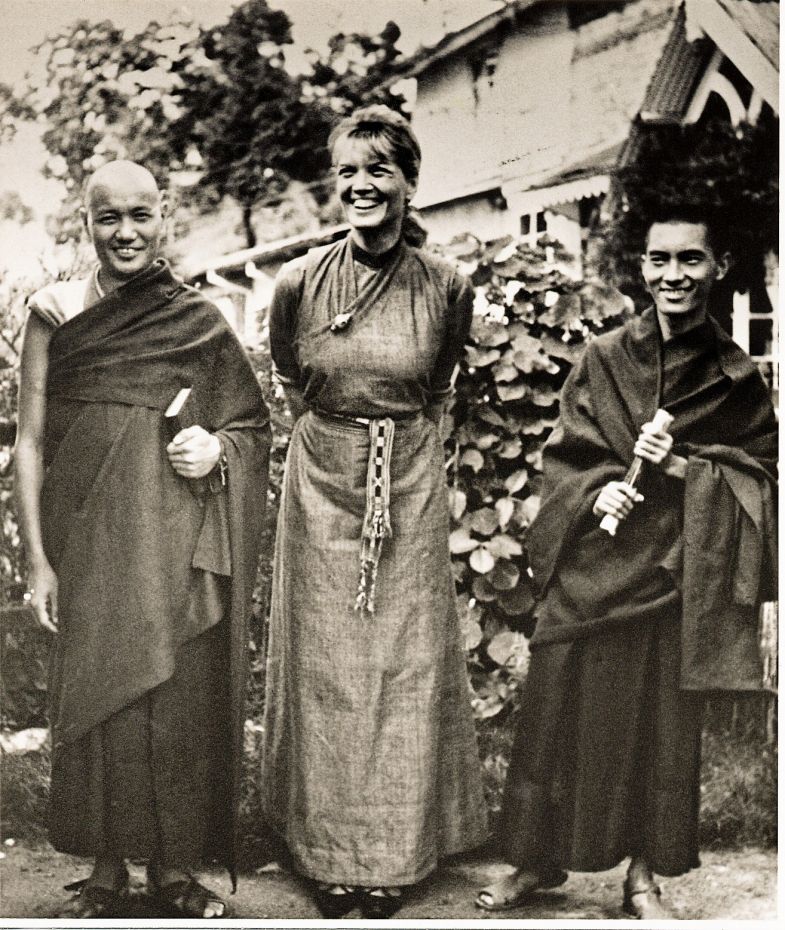
Zina Rachevsky with Lama Yeshe and Lama Zopa Rinpoche, 1967. Photo via Lama Yeshe Wisdom Archive.
In 1968, Max taught at the U.S. International Lincoln School in Kathmandu. She worked there until the early 1970s. She bought works of persecuted Jewish artists in Moscow and brought them to Kathmandu. In Kathmandu, she would purchase Tibetan thangkas and statues from Tibetan refugees. She opened an art gallery in a two-story building at Kantipath across from the American Embassy Consulate office. The gallery also had a café where poets, artists, and writers would meet.
Max developed good relations with King Mahendra as he was happy about her interest in promoting Nepali art. The King even inaugurated some of her exhibitions.
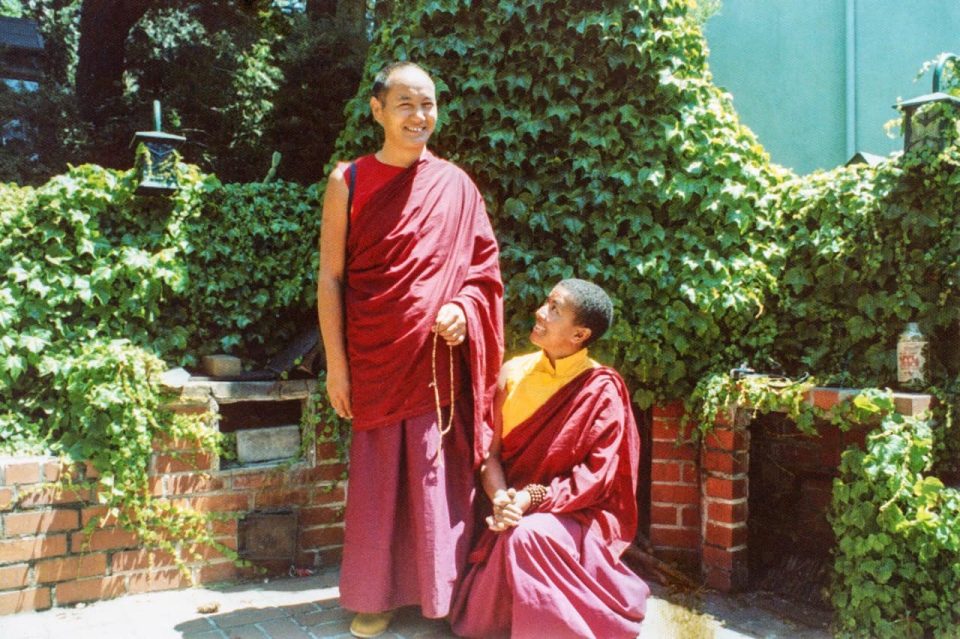
Lama Yeshe and Sister Max in Berkeley, California, 1974. Photo by Judy Weitzner
In 1968, Zina and Max met again in Kathmandu. By that time Zina had become a student of Lama Yeshe and Lama Zopa Rinpoche, traveled with the lamas, and finally settled in Kathmandu where they decided to build a monastery. Zina came to Max’s gallery where Max and her guests were having a Thanksgiving party and begged her to help take care of the lamas.
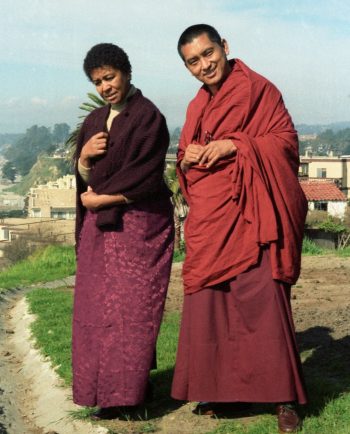
Max Mathews and Lama Zopa Rinpoche, Aptos, California, March, 1984. Photo by Åge Delbanco.
Max tells about her first meeting with Lama Yeshe and Lama Zopa Rinpoche in a 2020 interview:
So, Lama Yeshe was the first one I met, and he opened the door, folded his hands, and bowed to me. And at that time my heart went “Zoom! Open, open, open!” and I was on the floor and in tears. I was crying so hard because whatever he did to me, he put in my heart when he opened it, is still there. And I cried and cried. It was like years, but it was only like five minutes, and Lama Zopa then showed up. And that very moment from the floor, I promised Lama Yeshe because he requested me, and I gave my life, my heart, my body, mind, and soul to him forever, forever. As long as they needed me, I would do whatever I could to help them succeed with their journey. I promised the lamas, when I met them, that I would always be there for them and do and help as much as I could and provide service for them and their journey.
The same year Max visited old friends in Greece and met Marty Widener, who she married in a ceremony led by Lama Zopa Rinpoche and Lama Yeshe in Tinchuli, Bouddha.
Lama Yeshe and Lama Zopa Rinpoche finally found a suitable place for building a monastery. It was a house of an astrologer on Kopan hill. With Max’s financial help, they were able to buy the land. Max would spend her weekdays in the city and the weekends on Kopan hill.
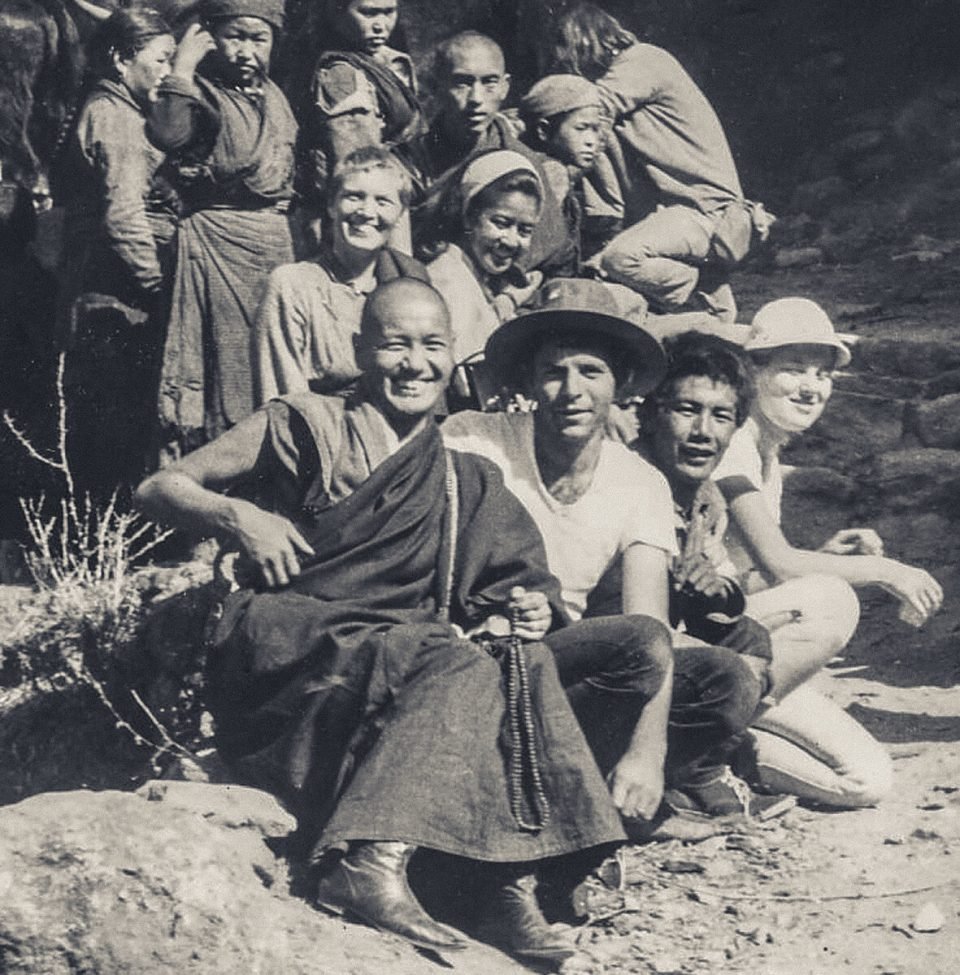
The trekking group to Lawudo, pictured from front: Lama Yeshe, Chip Weitzner, Dorje Sherpa, Judy Weitzner. Above: Zina, Max, and behind Max, Lama Zopa Rinpoche. Photo courtesy of Lama Yeshe Wisdom Archive.
In early 1969, Max, Zina, her film crew, Judy and Chip Weitzner, and the lamas left for Lawudo. Max discussed this trip in an interview from 2020:
We spent maybe a week in Namche. Many of the villagers knew Rinpoche. Lama Zopa was the Lawudo Lama. He had been in Tibet studying at the monastery, and people would come running out with kathas and gifts, just because Rinpoche had not come back since he left Lawudo to go to Tibet to study.
Now was the first time. So at this point he must have been early 20s. I’m guessing. I don’t really know, but the people recognized him and were so happy that he was back. And then everywhere we went, the people would come to Rinpoche, and they would request that he would please set up a traditional monastic school for boys. They begged and pleaded with him to open the school. I don’t remember Rinpoche’s response, but I’m sure he agreed, because first Mount Everest Center for Buddhist Studies was opened with 27 boys at Lawudo, which had become Lama Zopa’s cave.
The lamas decided to start Kopan in Lawudo and accepted the first group of young monks. Mummy Max was the main benefactor supporting the early growth of Kopan Monastery north of Bodhanath. “Max’s entire Lincoln School salary supported not only the early building at Kopan, but the entire education and maintenance of about 50 young Sherpa and Tibetan monks in the Mount Everest Centre school,” recalls Peter Kedge.
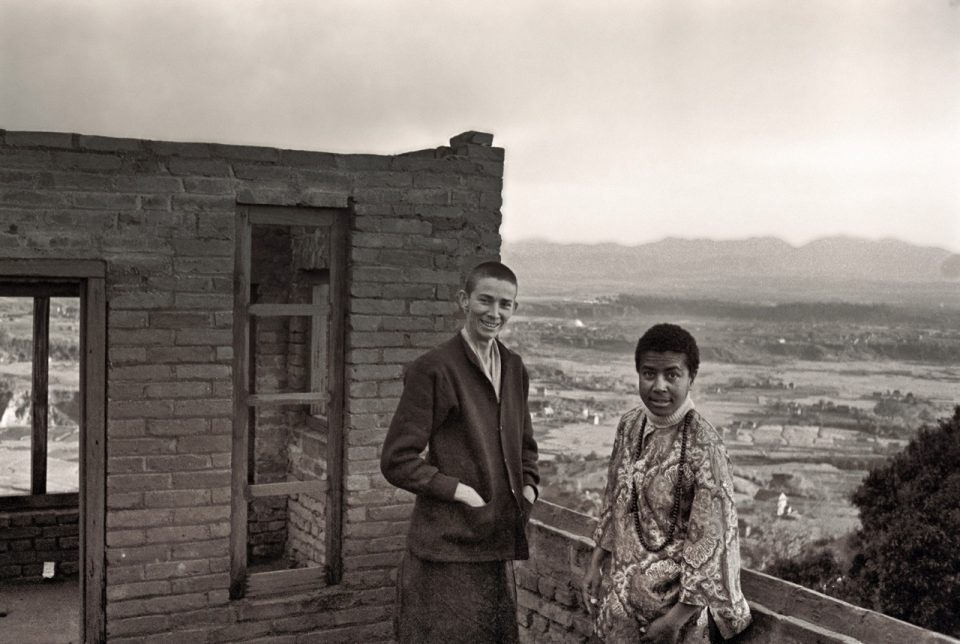
Anila Ann and Max Mathews on the roof of Kopan Monastery as the second floor is in progress, 1972. Photo courtesy of LYWA collection.
After coming back from Lawudo, Lama Yeshe started overseeing the construction works at Kopan hill. “We built resident quarters, kitchen, eating hall, and toilets and water and everything for bathing for the young monks,” Max shared. “And it took most of the ’70 and early ’71. By ’71, we had the first ordination.”
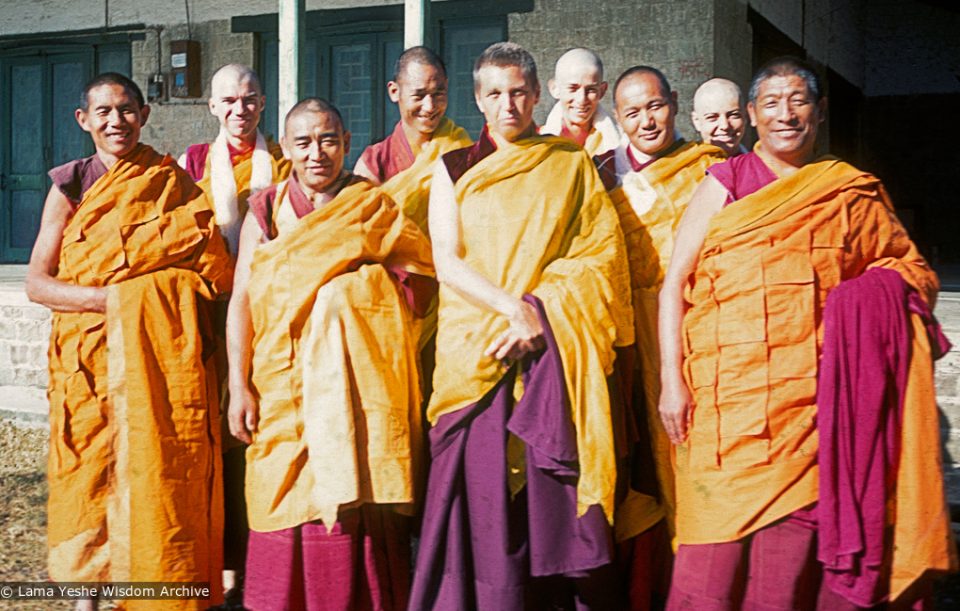
(12509_sl-3.psd) The first ordination of a group of western students, Dharamsala, India, 1970. Zina Rachevsky is in the front row between Gen Jampa Wangdu and Lama Yeshe. Ann McNeil (Anila Ann) is just to the right behind Zina, and Sylvia White is also in the back row to the right of Lama Yeshe. A student named James is second from left in back row, and Max Mathews, who also ordained that day, is curiously absent.
By 1971, there was enough space for small groups of students to come for the meditation course. Max recalled, “Westerners started getting notices to come to Kopan from the city, from everywhere around the world. And so, in ’71 we had the first course. And we had enough built that could take care of the small numbers that came. And then ’72 and ’73 was course two and three and going on.”
As Max was the principal source to support the Mount Everest Centre boys, she was concerned about a more enduring source of income, not just dependent on her personal salary. She decided to start a fashion business in Kathmandu with the first label “Samsara” and later moved her business to Delhi. Max shared, in Big Love:
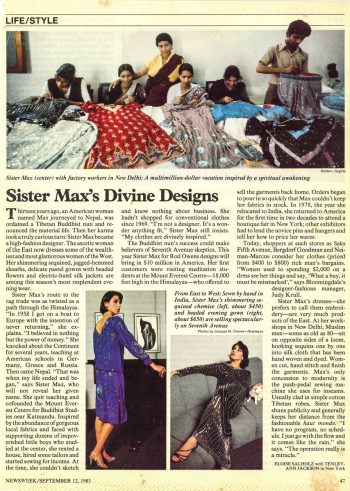
Time Magazine article on Sister Max Mathew’s fashion, September 12, 1983. Photo courtesy of LYWA collection.
Business was gradually getting better. I remember the first time I went back to America for my first show. I went to this huge convention center straight from the airport and didn’t even know how to price things, but everyone was helping me. From this tiny little stand at the show I sold everything I had and got back on the plane with all this money. I would never have had the courage to do that if I hadn’t gone back to the States first with Lama in 1974. I was flying, ten feet off the ground! I knew it was all due to Lama’s blessing. My first label was Samsara, then Yeshe, and then Sister Max, which was the one that succeeded.
Max was also part of the beginnings of what we call Universal Education. She wrote a program for teachers based on many discussions with Lama Yeshe. From Big Love:
Max Mathews stayed on the tour for the duration of her school holiday leave. In Nashville, Indiana, she spent time working on an innovative education project that Lama had discussed with her. Lama had told her he believed Buddhism could be taught all around the world without using any Buddhist terms at all and in such a way that children could learn that life is impermanent, all things are interrelated and the path to life’s fulfillment involves exercising compassion and wisdom and applying appropriate methods. Max thought the first thing to do was to prepare texts in order to be able to train teachers. She wrote out a program, developed concepts and had long discussions with Lama. News of her work elicited offers from two American universities to complete a PhD in educational research but she did not accept. When the lamas left for Wisconsin, Max returned to Nepal and her job at Lincoln School.
“Her diminutive size greatly belies the vastness of her compassionate heart and spirit,” Jan Willis said about Max in 1996 in an article she wrote for Mandala magazine, “Sister Max: Working for Others.”
In Big Love, Peter Kedge explained:
Sister Max unreservedly supported Lama Yeshe financially in whatever he undertook or needed. From the day they met, Max held nothing back, unhesitatingly providing whatever Lama needed. Max offered literally everything she had with a pure heart and never a thought for herself. Every time Max received her salary check from Lincoln School it immediately went for Lama and the Mount Everest Centre one hundred percent. Later, when Max had funds from her business, it was the same. Whatever Lama needed Max provided. Max knew when Lama was exhausted and she took him away and looked after him. Max spent whatever it took, whether for a comfortable place to stay, a nice hotel, a break for retreat, a holiday, a heater, good food, school supplies, building materials, food for the school or whatever. Max was always five hundred percent there for Lama. The way Max took care of Lama was the definitive lesson in generosity and an extraordinary inspiration. No one could have done more, and Kopan would not have existed without her unstinting support.
When Lama Yeshe passed away in 1984, Mummy Max, together with other senior students, sponsored pujas for Lama Yeshe. Ven. Yarphel (John Jackson) recalled in Big Love:
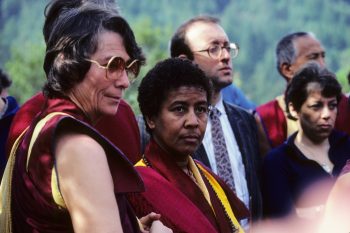
Cremation of Lama Yeshe, Vajrapani Institute, California, March, 1984. Photo includes Anila Ann, Max Mathews, Massimo Corona, Geshe Thinley, and Cecily Drucker. Photo by Ricardo de Aratanha.
It was interesting to see Sister Max’s complete lack of concern for her future. She paid for all the lamas to come here and overall, we had 175 people. Station wagons were hired to pick them up, everybody ate for free during that whole week. Everything was offered. Max and some old students paid for everything. At every puja all the lamas were offered hundreds of dollars in white offering envelopes—not like the usual $20 donations. Zong Rinpoche was offered about $1,000 at each puja and the others about $300 each.
We were making as many offerings as we could. We even drove through Santa Cruz offering money to hungry people on the street. The whole thing was under the advice of Zong Rinpoche and Lama Zopa, who was like his lieutenant. Sister Max eclipsed everybody. I didn’t see what she put through on her credit card, but of the $100,000 or so that I handled, $70,000 came from her. It was Max, of course, who had unhesitatingly paid the $15,000 bill from Cedars-Sinai Hospital.
The Car that Saved Mount Everest Centre
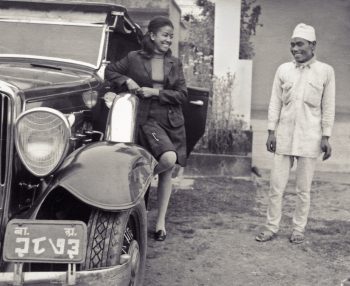
Max with her 1932 Hudson. Photo credit: Chitraker.
Shortly after they were built, two 1932 Hudson Phaeton cars were shipped to Calcutta, then carried by porters over the mountains into Nepal. That was the only way to bring vehicles into Nepal before the Raj Path was built in 1956. One of the vehicles was for the King of Nepal and the other was for the Prime Minister.
The history of at least one of the 1932 Hudson’s is really quite remarkable.
Max Mathews bought one of them from the King’s palace in the late 1960s. She recalled discovering that this car was available for purchase, “Wow, my heart starts racing and I have to get that car. I buy it, and I drive it around Kathmandu on the unpaved roads. There are no roads on Kopan at all, so that’s something we have to deal with.”
The car fell into disrepair and in 1972 Max asked Peter Kedge if he knew anything about cars. Indeed, he did! From age eleven, he had worked for two years in a bicycle shop, then at a garage during every school holiday until he graduated from university ten years later. By that time, he had spent more time working on cars than driving them. She asked whether he could help get the Hudson back into running condition. The car was stored in one of the Rana homes in Tintuli that Max was renting just outside Boudhanath. Peter spent three months at Tintuli with very few tools but did get the car running well again.
In the meantime, Max was the main benefactor supporting the early growth of Kopan Monastery north of Boudhanath. Peter stayed on at Kopan after the second course in 1972. He wanted to help and there was always work to do—either securing supplies for building the gompa, driving supplies to Kopan, managing the laborers, etc.
Max’s entire Lincoln School salary supported not only the early building at Kopan, but the entire education and maintenance of about 50 young Sherpa and Tibetan monks in the Mount Everest Centre School. In the summer months the school was held in Lawudo and in the Winter months the school would come down to Kopan where it was less cold.
In the Summer of 1973 an emergency message came down from Lawudo to Kopan saying that the school had run out of food and money.

The restored 1932 Hudson. Photo courtesy of Calvin Buchanan.
As always, taking full responsibility without any reservation Max immediately said to Peter, “Sell the Hudson.”
Peter placed an advertisement in the Rising Nepal newspaper and a gentleman from the U.S. Embassy responded, viewed the car, and purchased it. The proceeds from the sale of the Hudson saved the school and supported the 50 children and their teachers for quite a while.
The car was shipped through Calcutta to the U.S. and eventually ended up with a Hudson collector in Texas. A few years ago, the car’s owner, a collector who has more than twenty such vehicles, traveled to Santa Fe to meet Max and find out more about the car’s history. Since that time, the car has been completely renovated back to the original factory condition and colors.
Words of Thanks and Reverence for Max Mathews
On hearing the news of Mummy Max’s passing, many old and new friends around the world expressed moving tributes of thanks and reverence for Max. Here we share some of these sentiments:
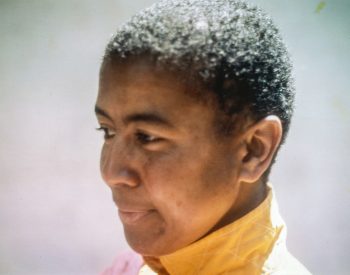
Max Mathews, 1974, Berkeley. Photo by Judy Weitzner.
“We rejoice how Mummy provided unconditional and essential support for the Lamas’ Western Dharma project as envisioned by His Holiness the Dalai Lama and remember how we are dependent upon Mummy Max for her mandala role in bringing the Dharma of Lama Yeshe and Lama Zopa Rinpoche to the West.” —From the Lama Yeshe Wisdom Archive
“Max’s dedication led her to play a crucial role in establishing and funding Kopan Monastery in the 1970s. Her generosity created a haven for spiritual seekers. Her passing marks the loss of a remarkable soul whose philanthropy touched many lives. Tonight, in the presence of Kyabje Khen Rinpoche, all the monks gathered to pray for her to be reborn in a higher realm and eventually attain Nirvana.” —From Kopan Monastery
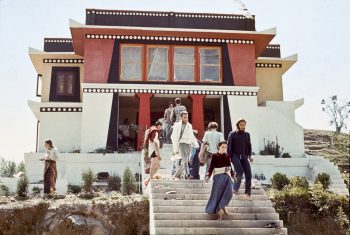
Front view of Kopan Monastery 1972, with students on the steps. Photo courtesy of the Lama Yeshe Wisdom Archive.
“It is impossible to imagine what Kopan (and the FPMT) might have been without her. When I first arrived at Kopan in the fall of 1972, Sister Max was single-handedly supporting the Lamas, thirty or so young Sherpa monks there at the time and the entire monastery infrastructure. She was a teacher at the American Lincoln School in Kathmandu and donated her entire salary to Kopan. Her generosity and devotion to Lama and Rinpoche were exemplary and inspiring and motivated many of us to devote ourselves to trying to emulate her in helping the Lamas in their mission to preserve and spread the Dharma for the enlightenment of all sentient beings. Today we see the incredible results. It would not have happened without her.”—From Nick Ribush
The Final Days: A Peaceful Transition
FPMT center, Thubten Norbu Ling, offered support to Max in her final days. They shared this moving account of her passing.

Max at the end of her life. Photo shared by Losang Dragpa Centre FPMT Facebook page
As Mummy Max celebrated her 90th birthday, little did we know that her journey on this earth was nearing its end. In her final days, the volunteers from The Buddhist Center took turns by her side, reciting Medicine Buddha Puja, The Eight Prayers to Benefit the Dead and Dying, The Vajra Cutter Sutra and many others. Messages, help and encouragement kept coming from around the world, and we spent the days doing practice, playing Lama Zopa’s mantras in the background and showing Mummy Max pictures of the lamas and holy objects.
Although weak, she was clear and attentive, holding our hands and sharing big smiles and hugs, whenever she woke up. She did not display any sign of pain, anxiety, or discomfort until her last breath. Her transition from this world was marked by a profound sense of peace, leaving those by her side feeling connected, uplifted, and inspired.
When Mummy Max stopped breathing, we were prepared. We managed to identify a local funeral home, which respected the Tibetan Buddhist customs. She was able to remain undisturbed in her apartment until she concluded her final meditation. The atmosphere in the room was clear and vivid, and Geshe Tenzin Zopa said that there was no doubt that Mummy Max was in the clear light meditation. At that time, we did practice in her room day and night, dedicating for her most fortunate rebirth. After two days, Geshe la confirmed that Mummy Max’s meditation came to an end.
Geshe la recited the Guhyasamaja Root Text and other prayers recommended before the removal of the deceased person’s body. Before Mummy Max’s worldly remains left the apartment, she was turned 3 times clockwise. Geshe la explained that according to Tibetan customs, sending the body off is like losing a precious gem and turning it three times allows for the precious energy to be preserved in our world system. Geshe la also checked for the best day suitable for cremation, which the funeral home agreed to honor.
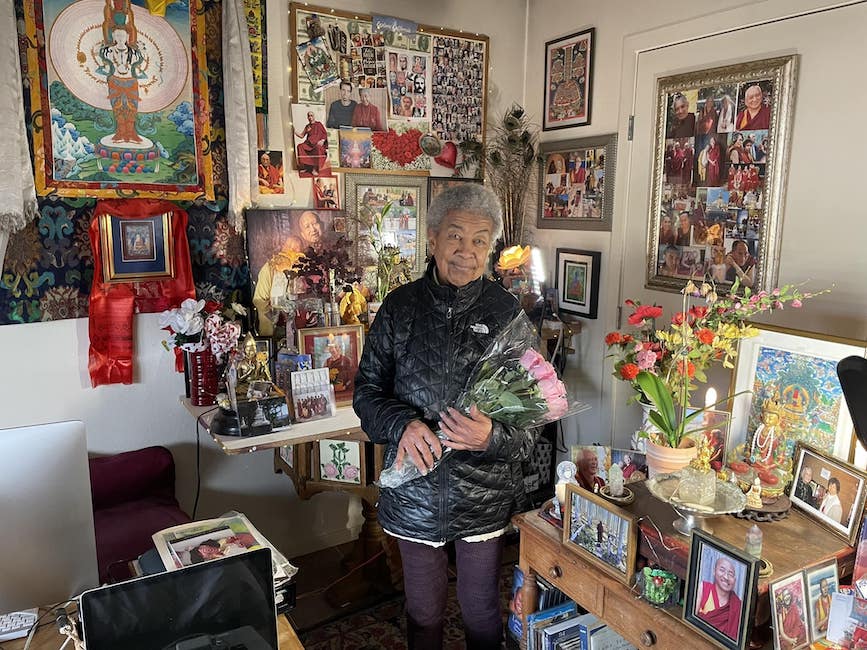
Mummy Max, Santa Fe, New Mexico, 2022. Photo by Steve Nadeau
“Mummy Max’s legacy lives on in our hearts, reminding us that through love, compassion and sincere practice, each of us can transcend the limitations of our human existence. As we reflect on Mummy Max’s life, we extend our deepest gratitude to our resident teacher, Geshe Thubten Sherab, Geshe Tashi Dhondup, Geshe Tenzin Zopa, and all the volunteers and supporters who selflessly dedicated their time and resources to ensure her peaceful and meaningful transition. Their unwavering commitment to her spiritual and physical well-being is a testament to the bonds of family and community that unite us all.” —Thubten Norbu Ling, Santa Fe FPMT Center, from a Facebook message following Max’s passing.
You can learn more about Max’s life in this 2020 interview, where she tells her own story about her relationships with the lamas. You can also read about Mummy Max’s first trip to Lawudo, as told by her old friend Judy Weitzner; find an excerpt about her in Big Love; an article by Jan Willis from Mandala magazine (1996), “Sister Max: Working for Others”; and an article from the Kathmandu Post, “The Enduring Legacy of Sister Max”.
Big Love, written by Adele Hulse, is the official, authorized biography of Lama Yeshe containing personal stories of the lamas and the students who learned, lived and traveled with them, as well as more than 1,500 photos dating back to the 1960s.
Please pray that Mummy Max Mathews may never ever be reborn in the lower realms, may she be immediately born in a pure land where she can be enlightened or to receive a perfect human body, meet the Mahayana teachings and meet a perfectly qualified guru and by only pleasing the guru’s mind, achieve enlightenment as quickly as possible. More advice from Lama Zopa Rinpoche on death and dying is available, see Death and Dying: Practices and Resources (fpmt.org/death/).
- Tagged: big love, fpmt history, mummy max, obituaries, obituary, road to kopan, ven max mathews
- Home
- News/Media
- Study & Practice
- About FPMT Education Services
- Latest News
- Programs
- New to Buddhism?
- Buddhist Mind Science: Activating Your Potential
- Heart Advice for Death and Dying
- Discovering Buddhism
- Living in the Path
- Exploring Buddhism
- FPMT Basic Program
- FPMT Masters Program
- FPMT In-Depth Meditation Training
- Maitripa College
- Lotsawa Rinchen Zangpo Translator Program
- Universal Education for Compassion & Wisdom
- Online Learning Center
- Prayers & Practice Materials
- Overview of Prayers & Practices
- Full Catalogue of Prayers & Practice Materials
- Explore Popular Topics
- Benefiting Animals
- Chenrezig Resources
- Death & Dying Resources
- Lama Chopa (Guru Puja)
- Lama Zopa Rinpoche: Compendium of Precious Instructions
- Lama Zopa Rinpoche: Life Practice Advice
- Lama Zopa Rinpoche Practice Series
- Lamrim Resources
- Mantras
- Prayer Book Updates
- Purification Practices
- Sutras
- Thought Transformation (Lojong)
- Audio Materials
- Dharma Dates – Tibetan Calendar
- Translation Services
- Publishing Services
- Teachings and Advice
- Find Teachings and Advice
- Lama Zopa Rinpoche Advice Page
- Lama Zopa Rinpoche: Compendium of Precious Instructions
- Lama Zopa Rinpoche Video Teachings
- ༧སྐྱབས་རྗེ་བཟོད་པ་རིན་པོ་ཆེ་མཆོག་ནས་སྩལ་བའི་བཀའ་སློབ་བརྙན་འཕྲིན།
- Podcasts
- Lama Yeshe Wisdom Archive
- Buddhism FAQ
- Dharma for Young People
- Resources on Holy Objects
- Ways to Offer Support
- Centers
- Affiliates Area
- Teachers
- Projects
- Charitable Projects
- Make a Donation
- Applying for Grants
- News about Projects
- Other Projects within FPMT
- Support International Office
- Projects Photo Galleries
- Give Where Most Needed
- FPMT
- Shop
Translate*
*powered by Google TranslateTranslation of pages on fpmt.org is performed by Google Translate, a third party service which FPMT has no control over. The service provides automated computer translations that are only an approximation of the websites' original content. The translations should not be considered exact and only used as a rough guide.It’s the foggy mind, the mind that’s attracted to an object and paints a distorted projection onto it, that makes you suffer. That’s all. It’s really quite simple.







